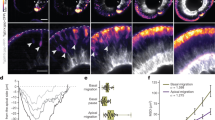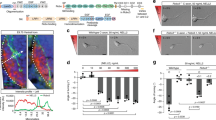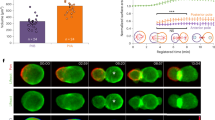Abstract
Local protein synthesis regulates the turning of growth cones to guidance cues, yet little is known about which proteins are synthesized or how they contribute to directional steering. Here we show that β-actin mRNA resides in Xenopus laevis retinal growth cones where it binds to the RNA-binding protein Vg1RBP. Netrin-1 induces the movement of Vg1RBP granules into filopodia, suggesting that it may direct the localization and translation of mRNAs in growth cones. Indeed, a gradient of netrin-1 activates a translation initiation regulator, eIF-4E-binding protein 1 (4EBP), asymmetrically and triggers a polarized increase in β-actin translation on the near side of the growth cone before growth cone turning. Inhibition of β-actin translation abolishes both the asymmetric rise in β-actin and attractive, but not repulsive, turning. Our data suggest that newly synthesized β-actin, concentrated near sites of signal reception, provides the directional bias for polymerizing actin in the direction of an attractive stimulus.
This is a preview of subscription content, access via your institution
Access options
Subscribe to this journal
Receive 12 print issues and online access
$209.00 per year
only $17.42 per issue
Buy this article
- Purchase on Springer Link
- Instant access to full article PDF
Prices may be subject to local taxes which are calculated during checkout







Similar content being viewed by others
References
Henley, J. & Poo, M.M. Guiding neuronal growth cones using Ca2+ signals. Trends Cell Biol. 14, 320–330 (2004).
Guirland, C., Suzuki, S., Kojima, M., Lu, B. & Zheng, J.Q. Lipid rafts mediate chemotropic guidance of nerve growth cones. Neuron 42, 51–62 (2004).
Wen, Z., Guirland, C., Ming, G.L. & Zheng, J.Q.A. CaMKII/calcineurin switch controls the direction of Ca2+-dependent growth cone guidance. Neuron 43, 835–846 (2004).
Zheng, J.Q. Turning of nerve growth cones induced by localized increases in intracellular calcium ions. Nature 403, 89–93 (2000).
Li, Y. et al. Essential role of TRPC channels in the guidance of nerve growth cones by brain-derived neurotrophic factor. Nature 434, 894–898 (2005).
Lohof, A.M., Quillan, M., Dan, Y. & Poo, M.M. Asymmetric modulation of cytosolic cAMP activity induces growth cone turning. J. Neurosci. 12, 1253–1261 (1992).
Ming, G.L. et al. Adaptation in the chemotactic guidance of nerve growth cones. Nature 417, 411–418 (2002).
Piper, M. et al. Signaling mechanisms underlying slit2-induced collapse of Xenopus retinal growth cones. Neuron 49, 215–228 (2006).
Wu, K.Y. et al. Local translation of RhoA regulates growth cone collapse. Nature 436, 1020–1024 (2005).
Campbell, D.S. & Holt, C.E. Chemotropic responses of retinal growth cones mediated by rapid local protein synthesis and degradation. Neuron 32, 1013–1026 (2001).
Shestakova, E.A., Singer, R.H. & Condeelis, J. The physiological significance of β-actin mRNA localization in determining cell polarity and directional motility. Proc. Natl. Acad. Sci. USA 98, 7045–7050 (2001).
Bassell, G.J. et al. Sorting of β-actin mRNA and protein to neurites and growth cones in culture. J. Neurosci. 18, 251–265 (1998).
Willis, D. et al. Differential transport and local translation of cytoskeletal, injury-response, and neurodegeneration protein mRNAs in axons. J. Neurosci. 25, 778–791 (2005).
Zhang, H.L. et al. Neurotrophin-induced transport of a β-actin mRNP complex increases β-actin levels and stimulates growth cone motility. Neuron 31, 261–275 (2001).
Zhang, H.L., Singer, R.H. & Bassell, G.J. Neurotrophin regulation of β-actin mRNA and protein localization within growth cones. J. Cell Biol. 147, 59–70 (1999).
Yuan, X.B. et al. Signalling and crosstalk of Rho GTPases in mediating axon guidance. Nat. Cell Biol. 5, 38–45 (2003).
Gebauer, F. & Hentze, M.W. Molecular mechanisms of translational control. Nat. Rev. Mol. Cell Biol. 5, 827–835 (2004).
Kloc, M., Zearfoss, N.R. & Etkin, L.D. Mechanisms of subcellular mRNA localization. Cell 108, 533–544 (2002).
Condeelis, J. & Singer, R.H. How and why does β-actin mRNA target? Biol. Cell 97, 97–110 (2005).
Huttelmaier, S. et al. Spatial regulation of β-actin translation by Src-dependent phosphorylation of ZBP1. Nature 438, 512–515 (2005).
Yisraeli, J.K. VICKZ proteins: a multi-talented family of regulatory RNA-binding proteins. Biol. Cell. 97, 87–96 (2005).
Sundell, C.L. & Singer, R.H. Requirement of microfilaments in sorting of actin messenger RNA. Science 253, 1275–1277 (1991).
Lopez de Heredia, M. & Jansen, R.P. mRNA localization and the cytoskeleton. Curr. Opin. Cell Biol. 16, 80–85 (2004).
Deiner, M.S. et al. Netrin-1 and DCC mediate axon guidance locally at the optic disc: loss of function leads to optic nerve hypoplasia. Neuron 19, 575–589 (1997).
Campbell, D.S. et al. Semaphorin 3A elicits stage-dependent collapse, turning, and branching in Xenopus retinal growth cones. J. Neurosci. 21, 8538–8547 (2001).
Hopker, V.H., Shewan, D., Tessier-Lavigne, M., Poo, M. & Holt, C. Growth-cone attraction to netrin-1 is converted to repulsion by laminin-1. Nature 401, 69–73 (1999).
Takei, N., Kawamura, M., Hara, K., Yonezawa, K. & Nawa, H. Brain-derived neurotrophic factor enhances neuronal translation by activating multiple initiation processes: comparison with the effects of insulin. J. Biol. Chem. 276, 42818–42825 (2001).
Wilkie, G.S., Dickson, K.S. & Gray, N.K. Regulation of mRNA translation by 5′- and 3′-UTR-binding factors. Trends Biochem. Sci. 28, 182–188 (2003).
Ando, R., Hama, H., Yamamoto-Hino, M., Mizuno, H. & Miyawaki, A. An optical marker based on the UV-induced green-to-red photoconversion of a fluorescent protein. Proc. Natl. Acad. Sci. USA 99, 12651–12656 (2002).
de la Torre, J.R. et al. Turning of retinal growth cones in a netrin-1 gradient mediated by the netrin receptor DCC. Neuron 19, 1211–1224 (1997).
Gingras, A.C. et al. Hierarchical phosphorylation of the translation inhibitor 4E–BP1. Genes Dev. 15, 2852–2864 (2001).
Eng, H., Lund, K. & Campenot, R.B. Synthesis of beta-tubulin, actin, and other proteins in axons of sympathetic neurons in compartmented cultures. J. Neurosci. 19, 1–9 (1999).
Ooashi, N., Futatsugi, A., Yoshihara, F., Mikoshiba, K. & Kamiguchi, H. Cell adhesion molecules regulate Ca2+-mediated steering of growth cones via cyclic AMP and ryanodine receptor type 3. J. Cell Biol. 170, 1159–1167 (2005).
Kuhn, T.B., Brown, M.D., Wilcox, C.L., Raper, J.A. & Bamburg, J.R. Myelin and collapsin-1 induce motor neuron growth cone collapse through different pathways: inhibition of collapse by opposing mutants of rac1. J. Neurosci. 19, 1965–1975 (1999).
Hansen, W.J., Cowan, N.J. & Welch, W.J. Prefoldin-nascent chain complexes in the folding of cytoskeletal proteins. J. Cell Biol. 145, 265–277 (1999).
Wang, J. et al. Reversible glutathionylation regulates actin polymerization in A431 cells. J. Biol. Chem. 276, 47763–47766 (2001).
Kislauskis, E.H., Zhu, X. & Singer, R.H. β-actin messenger RNA localization and protein synthesis augment cell motility. J. Cell Biol. 136, 1263–1270 (1997).
Lewis, A.K. & Bridgman, P.C. Nerve growth cone lamellipodia contain two populations of actin filaments that differ in organization and polarity. J. Cell Biol. 119, 1219–1243 (1992).
Oleynikov, Y. & Singer, R.H. Real-time visualization of ZBP1 association with β-actin mRNA during transcription and localization. Curr. Biol. 13, 199–207 (2003).
Yao, J., Sasaki, Y., Wen, Z., Bassell, G.J. & Zheng, J.Q. An essential role for β-actin mRNA localization and translation in Ca2+-dependent growth cone guidance. Nat. Neurosci. 9, 1265–1273 (2006).
Rousseau, D., Kaspar, R., Rosenwald, I., Gehrke, L. & Sonenberg, N. Translation initiation of ornithine decarboxylase and nucleocytoplasmic transport of cyclin D1 mRNA are increased in cells overexpressing eukaryotic initiation factor 4E. Proc. Natl. Acad. Sci. USA 93, 1065–1070 (1996).
Brunet, I. et al. The transcription factor Engrailed-2 guides retinal axons. Nature 438, 94–98 (2005).
Kanai, Y., Dohmae, N. & Hirokawa, N. Kinesin transports RNA: isolation and characterization of an RNA-transporting granule. Neuron 43, 513–525 (2004).
Liu, G. et al. Netrin requires focal adhesion kinase and Src family kinases for axon outgrowth and attraction. Nat. Neurosci. 7, 1222–1232 (2004).
Fan, J. & Raper, J.A. Localized collapsing cues can steer growth cones without inducing their full collapse. Neuron 14, 263–274 (1995).
Shirasaki, R., Mirzayan, C., Tessier-Lavigne, M. & Murakami, F. Guidance of circumferentially growing axons by netrin-dependent and -independent floor plate chemotropism in the vertebrate brain. Neuron 17, 1079–1088 (1996).
Zhang, Q. et al. Vg1 RBP intracellular distribution and evolutionarily conserved expression at multiple stages during development. Mech. Dev. 88, 101–106 (1999).
Yaniv, K., Fainsod, A., Kalcheim, C. & Yisraeli, J.K. The RNA-binding protein Vg1 RBP is required for cell migration during early neural development. Development 130, 5649–5661 (2003).
Chang, P. et al. Localization of RNAs to the mitochondrial cloud in Xenopus oocytes through entrapment and association with endoplasmic reticulum. Mol. Biol. Cell 15, 4669–4681 (2004).
Blichenberg, A. et al. Identification of a cis-acting dendritic targeting element in MAP2 mRNAs. J. Neurosci. 19, 8818–8829 (1999).
Acknowledgements
We thank M. Spira for suggesting use of Kaede–β-actin 3′ UTR; R. Adams for suggesting use of the Zenon labeling kit; J. Ireland and B. Kvinlaug for preliminary data on β-actin translation; J. Zheng, D. Campbell and L. Strochlic for sharing unpublished data; A. Dwivedy, I. Pradel and K. Zivraj for technical assistance; L. Poggi and J. Falk for help with image analysis; and W. Harris, M. Piper and D. Campbell for comments on the manuscript. This work was supported by a Croucher Scholarship (K.-M.L.), an EMBO Long Term Fellowship (F.P.G.v.H.), an NSF Graduate Research Fellowship (A.C.L.), a BBSRC Studentship (R.A.) and a Wellcome Trust Programme Grant (C.E.H.).
Author information
Authors and Affiliations
Contributions
K.-M.L. did the experiments on β-actin synthesis and function in Figures 3, 6, 7 and Supplementary Figure 2. F.P.G.v.H. did the experiments on Vg1RBP in Figures 1, 2, 4, Supplementary Figures 1 and 2k–o and Supplementary Videos 1,2,3,4. A.C.L. did the gradient assays on 4EBP and β-actin in Figures 5 and 6e. R.A. and N.S. provided Vg1RBP reagents and constructs and discussed experiments. K.-M.L., F.P.G.v.H., A.C.L. and C.E.H. wrote the manuscript and discussed experiments.
Corresponding author
Ethics declarations
Competing interests
The authors declare no competing financial interests.
Supplementary information
Supplementary Fig. 1
Netrin-1 induces transport of endogenous Vg1RBP and β-actin mRNA into filopodia. (PDF 2415 kb)
Supplementary Fig. 2
Differential β-actin translation in response to attractive and repulsive cues. (PDF 2725 kb)
Supplementary Fig. 3
Model for polarized synthesis of β-actin. (PDF 696 kb)
Supplementary Video 1
Movement of Vg1RBP-eGFP granules in retinal growth cones. Retinal explants taken from stage 33/34 embryos injected with Vg1RBP-eGFP mRNA were cultured for 24 hours and analyzed in real time. Images were taken every 12 seconds. Vg1RBP-eGFP granules show bidirectional movement in the axon shaft, growth cone central domain and filopodia. (MOV 1151 kb)
Supplementary Video 2
The effect of cytochalasin D on Vg1RBP-eGFP granules movement. Live imaging of Vg1RBP-eGFP positive growth cones. Bath application of cytochalasin D (0.1 μM) results in retraction of Vg1RBP-eGFP granules from the growth cone. Images were taken every 12 seconds. (MOV 598 kb)
Supplementary Video 3
Movement of Vg1RBP-eGFP granules into filopodial contact sites. Live imaging of Vg1RBP-eGFP positive growth cones. The arrows indicate anterograde transport of a Vg1RBP-eGFP granule moving to the contact site, followed by a pause and retrograde movement to the base of the filopodium. Images were taken every 12 seconds. (MOV 1297 kb)
Supplementary Video 4
Netrin-1 induces transport of Vg1RBP-eGFP granules into filopodia. Vg1RBP-eGFP expressing retinal growth cones were stimulated with netrin-1 after 5 minutes and followed in real time. Images were taken every 12 seconds for 15 minutes. The arrows indicate filopodia in which the increased transport of Vg1RBP-eGFP granules is very prominent. (MOV 1675 kb)
Rights and permissions
About this article
Cite this article
Leung, KM., van Horck, F., Lin, A. et al. Asymmetrical β-actin mRNA translation in growth cones mediates attractive turning to netrin-1. Nat Neurosci 9, 1247–1256 (2006). https://doi.org/10.1038/nn1775
Received:
Accepted:
Published:
Issue Date:
DOI: https://doi.org/10.1038/nn1775
This article is cited by
-
The Axonal Actin Filament Cytoskeleton: Structure, Function, and Relevance to Injury and Degeneration
Molecular Neurobiology (2024)
-
Genome-wide translation control analysis of developing human neurons
Molecular Brain (2022)
-
RNP components condense into repressive RNP granules in the aging brain
Nature Communications (2022)
-
Neuronal subtype-specific growth cone and soma purification from mammalian CNS via fractionation and fluorescent sorting for subcellular analyses and spatial mapping of local transcriptomes and proteomes
Nature Protocols (2022)
-
Intracellular mRNA transport and localized translation
Nature Reviews Molecular Cell Biology (2021)



